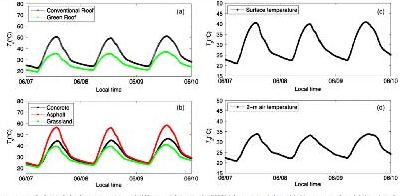Today we review research on the urban heat island effect and how green roofs and high albedo “cool” roofs may be used to mitigate the amount of heating – which is becoming an even more important aspect, as global climate warming continues to increase the frequency and severity of heat waves in cities with the resultant growing impact on health. Results of the modeling show that over 90% of the roofs have to be green or cool in order to reduce the average air temperature by 0.5 C. Also, the soil moisture is critical for green roofs as dry soil has minimal effect on cooling.
 Key Quotes:
Key Quotes:“global climate change is expected to exacerbate the heat conditions in urban environment …heat waves, which are projected to become more frequent and last longer under a warming climate, interact nonlinearly with UHIs (urban heat island) to produce extremely high heat stresses for urban residents”
“A green roof increases the evapotranspiration in urban areas through soil and plants on rooftops (redirecting available energy to latent heat), while a cool roof increases the reflection of incoming solar radiation in urban areas by increasing the albedo of roof surfaces”
“the daytime surface temperature of a green roof is substantially lower than that of a conventional roof due to evapotranspiration. The nighttime surface temperature on the green roof is also lower but the differences between roofs are less drastic”
“the significant cooling effect of green roof during daytime can probably last throughout the night due to reduced heat storage in the urban canopy”
“The cool roof strategy has a lower impact on the nighttime surface urban heat island than on the daytime surface urban heat island….the cool roof fraction that is needed for reaching a maximum reduction in the surface urban heat island of 1 °C is also about 30%... Approximately 95% cool roof coverage is needed in order to reduce the near-surface urban heat island by 0.5 °C at the time when the near-surface air temperature reaches its maximum.“ “when the soil moisture initial condition is somewhat dry (i.e., initial soil moisture is 0.15 or 0.25 m3m–3), the performance of green roof deteriorates significantly. "
“The performances of green roofs and cool roofs are primarily affected by soil moisture and albedo, respectively”
“To reduce the near-surface UHI by 0.5 °C, the green roof fraction has to be close to 90% and the cool roof (albedo=0.7) fraction has to be close to 95%”
No comments:
Post a Comment